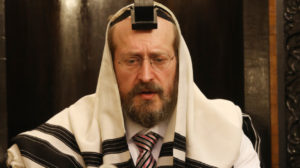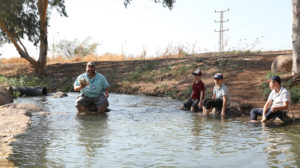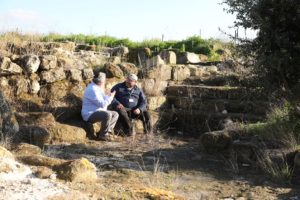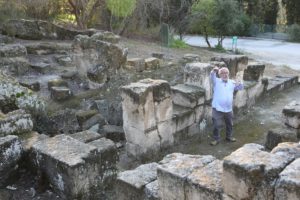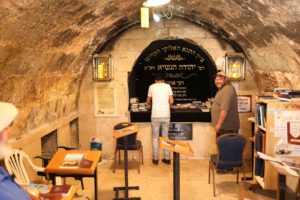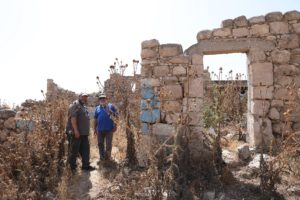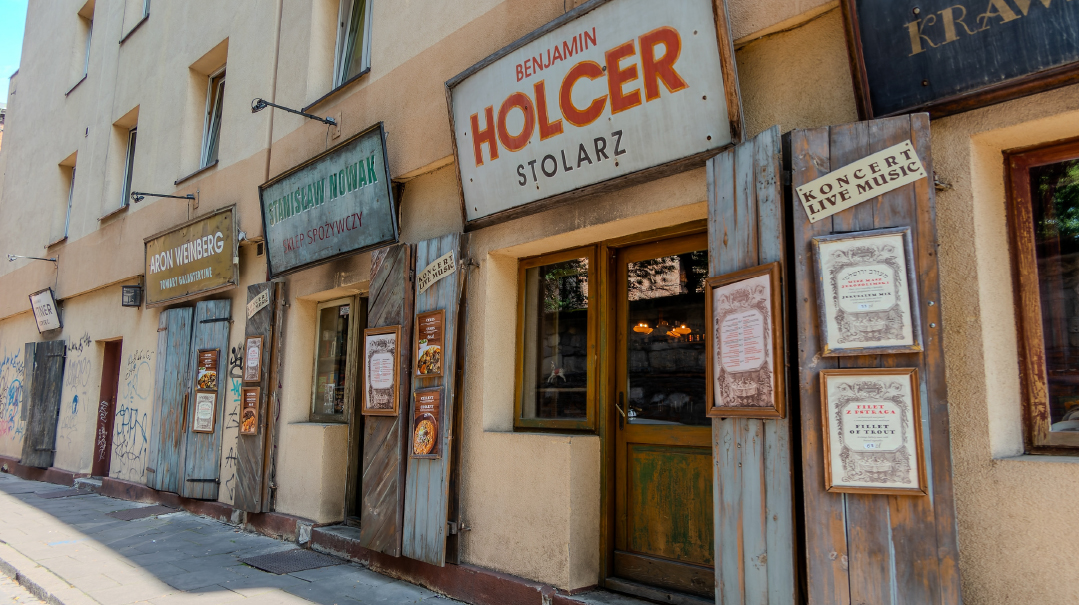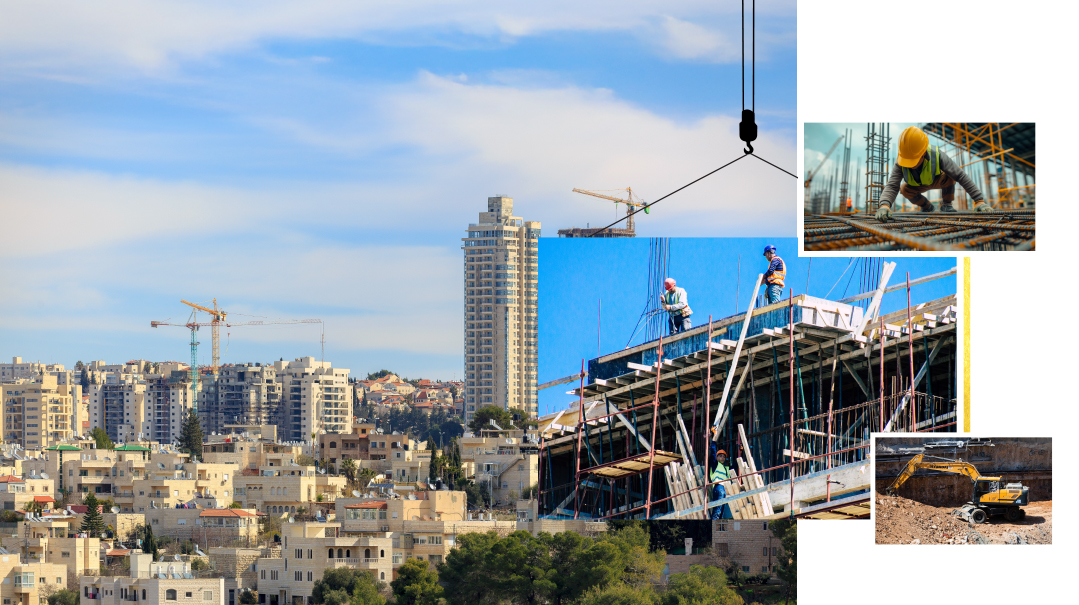Doorways to Redemption
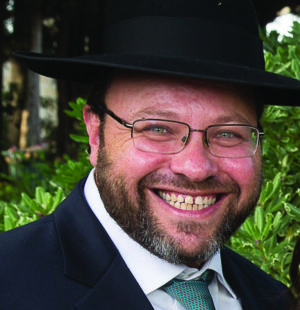
These gates will soon usher in an era we’ve been dreaming about for centuries
Photos: Menachem Kalish | Video: Menachem Kalish, Gil Mezuman
Rebbi’s Classroom
Perhaps Hillel Hazakein could teach the entire Torah while standing on one foot, but to cover the entire 120-kilometer Sanhedrin Trail — the various stations of the Sanhedrin in the Galilee after it was forced northward following the destruction of the Beis Hamikdash — takes at least two Mishpacha articles. In Part I, we visited Usha and Shefaram, where the Sanhedrin first moved after the Churban, and davened by the grave of Rebbi Yehuda Ben Bava, who ordained the generation of Tannaim in the aftermath of the debacle of the Bar Kochva revolt.
Today we’re going to move southward to the Sanhedrin’s next station, and start our tour in the quaint yishuv of Kiryat Tivon at the National Park of Beit Shearim. I’ve guided groups to Beit Shearim often (back in the days when tourists actually came to Israel in person), and what not everyone knows is that besides being a UNESCO-recognized World Heritage site — which generally doesn’t interest most tourists anyway — it also served as the central burial place for Klal Yisrael for hundreds of years after the Churban, when the Jews no longer had access to Har Hazeisim. The ancient burial caves are an incredible place to learn about the various ancient minhagei kevurah that are mentioned in the Gemara. As well, the inscriptions on the burial caves of those that came from all over the Middle East, and even Europe, are a testimony to the significance placed on kevurah in Eretz Yisrael even in ancient times.
Accompanying me once again is Dr. Chagi Amitzur, the visionary who developed this trail and, together with the Ministry of Antiquities, brought it to fruition in 2018.
He points out a large complex with bleacher-like seats in a half circle, which some theorize was the meeting place of the Sanhedrin once it moved from Shefaram. The move from Usha and Shefaram to a more central and larger city is a testimony to the changing status from the early days after the revolt, when Jews were on the run, to a community that had rebuilt relationships with its Roman occupiers and had come to accommodations with them. And the credit for that changing relationship goes to the city’s most prestigious resident and chief rabbi: Rabi Yehudah Hanasi — “Rebbi.”
The Gemara tells us that Rebbi lived the majority of his life here. For the last 17 years of life he relocated to Tzippori, bringing the Sanhedrin with him (and drawing a parallel to Yaakov Avinu, who lived in Mitzrayim for his last 17 years). Rebbi was the wealthiest person of his generation, and utilized that wealth to support the Jewish People in times of hunger and in gaining influence with Antoninus, the Roman ruler. Those improved relationships presented an opportunity for Rebbi’s most monumental work: the editing of the Mishnah. Although the writing of what was meant to be exclusively an oral tradition was itself a Torah prohibition, the circumstances were extenuating and indeed, the future of the nation and our connection to Torah depended on it. The Jewish People had dispersed, and there was no longer a central Beis Hamikdash to unify the nation. The future rested on Torah study, and Rebbi became our eternal teacher.
On a hill above the aforementioned burial caves are the ruins of a very large multi-pillared room known as a basilica. This was a community center that was common in larger Roman cities, and the Jewish community of Beit Shearim, in keeping with the times, built one for themselves as well. What’s most fascinating about this complex, Chagi points out to me, is that this basilica is constructed with a colonnade consisting of six pillars that must have held up a roof. On its own that doesn’t seem to be significant, until you open the Talmud Yerushalmi in Eiruvin that mentions a dispute between Rabi Chiya and Rabi Yosi as to whether there were six or eight pillars in the achsadra, or colonnade, of Beit Shearim. Rabi Yaakov bar Acha explains that this really isn’t a dispute, rather the opinion saying there were eight was also including the two pillars outside of the gate. And sure enough, as we walk out the gate of the basilica, there still stand the remains of these two other famous Talmudic-era pillars.
On the side of the basilica there is a small little classroom. I asked Chagi if it was really here that Rebbi wrote and taught the Mishnah to his sons and students? I don’t know for sure, but I was moved to sit down, crack open a Mishnah, and read Rebbi’s words right here. It doesn’t get much better than that.
Better Homes
On the road leading out of the park we stop by a large complex that has a big sign reading “Beit Knesset.” I’ve often stopped here, but now Chagi says he has something special to show me. First of all, he explains that this is clearly not a synagogue. Sorry to all of those tourists who have been misled, but the shul is in fact behind this complex and can’t be seen from the street. So, what is this palatial structure we’re standing in? Chagi tells me that it’s none other than the house of Rebbi. “Whoa,” I say skeptically. “How can you possibly know that?”
Chagi presents the evidence. First of all, the Talmud tells us that Rebbi’s house was close to the shul, and as you walk out of the house you can see that the shul was just three minutes away. In addition, the Talmud tells us about the wealth of Rebbi and how he had a bathhouse inside of his home with both hot and cold baths. Sure enough, Chagi shows me the remnants of the hypocaust (Roman hot bath) and its adjacent cool bath.
Secret to the Grave
Heading eastward on Highway 77, we stop at the entrance to the yishuv of Hoshaya at Mitzpeh Sando, where we notice a hill with an Israeli flag waving on it. In 2007, local farmers around Eretz Yisrael formed a Jewish watchmen society called Hashomer Hachadash to protect Jewish fields from the scourge of local Arab thieves. Since its inception, farm theft has dropped 80% and there are tens of thousands of volunteers all over the country who spend nights standing guard over Jewish land. From this lookout we see the flourishing wheat fields of the Netofa valley. As there is no drainage in this valley, it remains wet and fertile much longer than anywhere else — and thus the Talmud tells us that it is halachically the last place where crops remain regarding the cycles of shemittah and maasaros.
Continuing along a dirt road from there, we arrive at the foot of Tzippori, the once-magnificent capital of the Galilee and the city to where Rebbi transferred the Sanhedrin and completed the Mishnah. Tzippori had a mixed Jewish-Roman population for several centuries and there are many fascinating remains of both cultures here, but what specifically interests us is a gravesite below the ancient city — and one of the more confusing kevarim in Eretz Yisrael. There is one sign stating that we have arrived at the kever of Rabi Yehudah Hanasi, yet underneath that there is another sign that says it’s the grave of Rabi Yehudah Nesiah, the grandson of Rebbi — the son of Rabi Gamliel.
The controversy revolving around the identity of this kever is that the Gemara explicitly states that upon Rebbi’s death, he was eulogized in 18 shuls in Tzippori and was taken to Beit Shearim, where he had prepared a place to be buried — and, in fact, there is a tomb of Rebbi there as well. We even know Bar Kapparah’s eulogy of that funeral, which is used for the passing of all gedolim: “Areilim nitzchu es hametzokim v’aron Hashem nishba — the angels have won over the righteous and the aron of Hashem has been taken.” Yet for centuries, famous travelers such as Binyamin of Tudela and Pesachya of Regensburg all attest to Rebbi’s tomb being here in Tzippori.
There are some who suggest that because Rebbi died on Erev Shabbos perhaps there was no time to take him to Beit Shearim, and thus he was buried in Tzippori. On the other hand, there is certainly much archeological evidence to support the Talmud’s statement that he was buried in Beit Shearim, which was entirely abandoned during the centuries when the early travelers came to Eretz Yisrael. In Rebbi’s will that we have recorded, it states that he wished to be buried directly in the ground, and after touring Beit Shearim’s burial caves, each with its ornate sarcophagi, we can appreciate the startling simplicity of the kevarim thought to be of Rebbi and his wife in Beit Shearim, that are just cut in the ground with no markers.
As well, in the room adjacent to Rebbi’s grave in Beit Shearim, three inscriptions were found with the names Shimon, Gamliel and Chanina Hakatan, the names of Rebbi’s two sons and primary student whom he commanded to take care of his burial. Perhaps the most compelling evidence of the Beit Shearim theory is a Gemara telling us that a beis medrash was built upon the grave of Rebbi, and that would explain the bleachers we had seen in Beit Shearim that rest above his tomb.
Still, the kever of Yehudah Hanasi remains a mystery. Actually, his death itself is a bit of a mystery as well. For according to the Gemara in Kesubos, Rebbi would return after his death each Friday night and make Kiddush for his family. For like Yaakov Avinu of whom Chazal tells us was “lo meis,” Rebbi too lives on as the eternal rebbi of Klal Yisrael.
When in Rome
On our next stop, we hope we might even meet Mashiach. For Eliyahu Hanavi revealed to Rabi Yehoshua ben Levi that Mashiach is sitting at the entranceway to Rome. Now, Rome is quite a journey from here and it’s hard to believe that Mashiach would be hanging out around the Vatican. But wouldn’t you know it, we have our own Rome in Eretz Yisrael as well. It turns out that not far from Tzippori is a Bedouin village called Rumat al Heib, which is right next to another Arab village named Rumana. Both of these villages have preserved the ancient name of Rome in their names, and the ruins, called Churbat Roma, still stand tall in the fields outside of the village. Driving through the Bedouin village, Chagi assures me that despite the recent uprising of the Arabs in the Galilee last month, this Bedouin village is quite patriotic, having established its own unit in 1948 to join forces with the Israeli army serving as trackers, and that unit still exists today. They definitely seemed to have been blessed for their efforts, for as we pass mansion after mansion, it seems that they’re living a similar affluent lifestyle as those who lived here 2000 years ago. One of the prestigious residents of this ancient mixed Jewish and Roman city back then were the descendants of Nakdimon Ben Gurion of Jerusalem, who supported the entire Galilee during times of famine from the abundant storage houses he had here. This area around Tzippori, Reish Lakish tells us, is the “milk and honey” the Torah describes, and Roma was its “Hamptons.”
The ancient ruins, though, are overrun with weeds and rubble. We see the broken-down gateway, but there’s no sign of Mashiach. We find the entrance to the ancient tunnels — the longest found in the Galilee — which seem to lead in the direction of Tzippori and could very well be those very tunnels through which Antoninus would go in order to visit Rebbi.
The Seder Hadoros, in fact, writes that the famous story of Kamtza and Bar Kamtza that led to the Churban, concluding with Bar Kamtza traveling to “Rome” where he convinced the ruler of the disdain the Jews had for him, took place right here. If this is indeed the “Rome” being referred to, it means that here is where the destruction started, and it is from here that Mashiach is waiting to redeem us.
Rising Star
Our next destination along the Sanhedrin Trail, Mount Arbel, overlooking the Arbel Valley, continues the redemption theme. For it is in this valley where Rabi Chiya and Rabi Shimon Ben Chalafta were walking as they saw the morning light burst forward through the cracks in the mountain ridge and exclaimed that this is the way the redemption will happen: Bit by bit the light will get larger and brighter. But on the way to Arbel, we first pass another incredible outlook over the Rimon Valley, right outside of Chagi’s home in Beit Rimon. There he points out the spot where the valley is hidden between the hills, and right at that spot, the Sanhedrin was renewed in order to renew the calculation of leap years. Rabi Yehoshua ben Chaninah got up at the famous gathering and shared the parable of the stork that pulled the bone out of the lion’s mouth in order to save him, and upon asking for his reward was told that he should be satisfied with the knowledge that he stuck his head in a lion’s mouth and survived to tell the tale. The message was obvious: Jewish life would continue away from Jerusalem and we should be grateful that we survived.
Mount Arbel is a national park, and it’s also a challenging hiking trail, climbing down its jagged precipice cliffs to the valley near Teveria below. It is definitely not a climb for the faint of heart or for tour guides that have been sitting on a couch for a year and half — and it was not happening today. Instead, we limited our visit to the ancient remains of the shul that dates back to the times of Nitai Ha’arbeli, one of the “pairs” mentioned in Pirkei Avos who passed down the mesorah from Sinai, and who lived in the period of the Chashmonaim. The shul where we’re standing is currently under some reconstruction maintenance, but it still is very impressive. Its decorative columns and ornate structure are reflective of a community that was very wealthy and that invested years of construction in an edifice that would serve them for a very long time, which it did. It is estimated that the community in Arbel lasted for more than a thousand years, as the large suburb of its neighboring city of Teveria.
What stands out most is the immense entrance gate to the shul that is remarkably carved out of one stone. From the remains, it is apparent that there were two smaller side gates also carved out of the same stone. Weighing in at a few tons, it’s mind-blowing to think about how they hauled it up this mountain. And it also begs the question as to why it wasn’t constructed in several pieces, as were most shul gateways at the time. Another anomaly about this entranceway is that, as opposed to other shuls in the Galilee where both the entrance and the aron kodesh face south toward Jerusalem, here the aron kodesh faces south, but the entrance gate is on the eastern wall.
Yet the Arbel shul’s mysteries, like so much else, can be solved by examining the words of our Sages who lived at the time. Chazal record that the eastern entrance gate to the Har Habayis was given unique significance, as it says in Midrash Shir Hashirim on the verse Mashgiach min hachalonos: “This is Mashiach. For when he comes the eastern gates (from where the sun rises) will open up for him.”
And in the Pesikta d’Rav Kahane it’s recorded: “In the future Hashem will build the eastern gate of Jerusalem, it and its two side entrances are all carved out of one precious stone.”
Mount Arbel, where the great rabbis saw the redemption coming as a morning star from the east, was a site where there was much upheaval in the times of the Beis Hamikdash during the period of Herod and afterward. Rabi Eliezer HaKalir wrote that the ultimate battle of Gog and Magog will take place not far from here, in Karnei Chittin. And so, the architects of this shul wished to fortify this idea in the building of this incredible shul with its eastern gate in order to welcome Mashiach.
End of the Trail
It was long past the morning star’s rising at this point — by now it was the evening star and sunset that we were racing against. Fortunately, having learned my lesson from our last tour fiasco when a flat tire sent us into a ditch somewhere in the Nachal Tzippori, I now came prepared with my 4×4 Ford Explorer, which afforded us a scenic short cut straight down the slopes of Mount Arbel, where we enjoyed breathtaking views of the entire Kinneret and the Golan Heights all the way to Mount Hermon. (Along the way we drove through the first and original esrog orchards that were planted in Eretz Yisrael by Reb Yisrael M’Shklov, a student of the Vilna Gaon and author of the Pe’as Hashulchan. Fifty years later, in 1873, Rav Chaim Elazar Wax, author of the responsa Nefesh Chaya, came to Eretz Yisrael and planted over 1,300 esrog trees that produced over 40,000 esrogim not far from here. He opposed the “Korfu” esrogim that were being used in Europe and in Eretz Yisrael. Today those fields produce delicious citrus fruits.)
Our last stop on the Sanhedrin Trail is in Teveria by the banks of the Kinneret, not far from the tomb of Rabi Meir Baal Haneis. Teveria was the final station of the Sanhedrin, and tradition has it that Mashiach will reestablish the Sanhedrin here before going to Jerusalem to rebuild the Mikdash. That’s why for centuries, Jews chose to be buried here — the largest number of the post-Mishnaic kevarim in the Galilee are found in this area. Whether it is the tomb of the Rambam, the talmidim of the Gra or of the Baal Shem Tov, great men saw in Teveria the place from where the redemption would begin to be realized. Far be it from me to read into modern-day events, but in the 1948 War of Independence, this was the first mixed city that the Israeli army conquered and that was officially declared under Jewish hands.
As we stand along the banks of the Kinneret, Chagi points to the spot where, according to tradition, the Well of Miriam rolled in the Kinneret when Bnei Yisrael first entered the Land. The exact location is described in a story recorded by Rav Chaim Vital, who was having difficulty understanding a kabbalistic concept that his rebbi, the Arizal, was trying to teach him. The Ari then brought him down from Tzfas and hired a fisherman to take them out to the Kinneret, near pillars that were in the water (which are still here). He then took a cup, scooped up some water, and gave it to Rav Chaim to drink — and the olamos ha’elyonim opened up before him. The Ari told him he’d just drunk from the Well of Miriam.
It was the perfect moment for us to make a l’chayim as well. We toasted the long historic journey our People have taken since the Churban Beis Hamikdash nearly 2000 years ago, and the tenacity to maintain and rebuild from those ashes our Torah, our faith and our nation. The Sanhedrin Trail has taken us from the small village of Usha (“yi’ush – hopelessness”), to the larger village of Shefaram (“improvement of the nation”), to Beit She’arim (just as Yitzchak Avinu was blessed with “meah she’arim,” a 100-fold of his crops), to Tzippori (where we rose like a bird), and finally, to Teveria, where we await Mashiach’s final return.
The Gemara in Rosh Hashanah tells us that the travels and exile of Sanhedrin correspond to the stages and exile of the Shechinah. After 2,000 years we hope we’ve reached the end of our trail as well.
(Originally featured in Mishpacha, Issue 866)
Oops! We could not locate your form.

